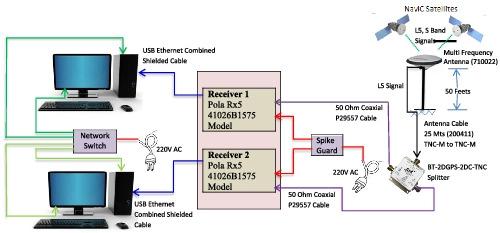当前位置:
X-MOL 学术
›
Int. J. Satell. Commun. Netw.
›
论文详情
Our official English website, www.x-mol.net, welcomes your feedback! (Note: you will need to create a separate account there.)
Double difference method with zero and short base length carrier phase measurements for Navigation with Indian Constellation satellites L5 (1176.45 MHz) signal quality analysis
International Journal of Satellite Communications and Networking ( IF 1.7 ) Pub Date : 2022-04-07 , DOI: 10.1002/sat.1441 Swamy KCT 1 , Venkata Ratnam Devanaboyina 2 , Towseef Ahmed Shaik 1
International Journal of Satellite Communications and Networking ( IF 1.7 ) Pub Date : 2022-04-07 , DOI: 10.1002/sat.1441 Swamy KCT 1 , Venkata Ratnam Devanaboyina 2 , Towseef Ahmed Shaik 1
Affiliation

|
The carrier phase (CP) measurements should be unambiguous to achieve the enhanced accuracy of Global Navigation Satellite System (GNSS) services. However, all the real-time CP measurements are manipulated by different errors, namely, satellite and receiver clock error, ionosphere delay, troposphere delay, integer ambiguity, etc. Even after removing or minimizing all these errors, the CP measurements are influenced by multipath error and receiver hardware residual or bias. In this research article, a double difference (DD) method is proposed to estimate residual or bias in CP observations of Navigation with Indian Constellation (NavIC). The proposed method abolishes all the common errors and provides bias. However, the CP measurement with a bit of bias value can be considered a high-quality signal. Here, we investigate the quality of NavIC satellites L5 (1176.45 MHz) signal with real-time measurements obtained through zero base length (ZBL) and short base length (SBL) experiments conducted at Kurnool (15.79°N, 78.07°E), India. The results show that the CP measurement bias of the L5 signal is within the range ±0.338 and ±1.688 m, respectively, for stationary and moving receivers. The bias was enhanced to 3.71 m for the SBL measurements. The results also demonstrate that the bias is low when carrier to noise (C/No) is high, and its range is nearly the same for all the days. This research would be helpful to estimate the bias that improves accuracy of precise point positioning (PPP) applications.
中文翻译:

使用印度星座卫星 L5 (1176.45 MHz) 信号质量分析进行零基长载波相位测量和短基长载波相位测量的双差分法
载波相位 (CP) 测量应该是明确的,以提高全球导航卫星系统 (GNSS) 服务的准确性。然而,所有实时 CP 测量都受到不同误差的影响,即卫星和接收机时钟误差、电离层延迟、对流层延迟、整数模糊度等。即使在消除或最小化所有这些误差之后,CP 测量也会受到多径的影响误差和接收器硬件残差或偏差。在这篇研究文章中,提出了一种双差 (DD) 方法来估计印度星座导航 (NavIC) 的 CP 观测中的残差或偏差。所提出的方法消除了所有常见的错误并提供了偏差。然而,带有一点偏差值的 CP 测量可以被认为是一个高质量的信号。这里,我们通过在印度 Kurnool(15.79°N,78.07°E)进行的零基础长度(ZBL)和短基础长度(SBL)实验获得实时测量结果,研究 NavIC 卫星 L5(1176.45 MHz)信号的质量。结果表明,对于静止和移动接收机,L5 信号的 CP 测量偏差分别在 ±0.338 和 ±1.688 m 范围内。SBL 测量的偏差提高到 3.71 m。结果还表明,当载噪比 (C/No) 较高时,偏差较低,并且其范围在所有日子里几乎相同。这项研究将有助于估计提高精确点定位 (PPP) 应用程序准确性的偏差。45 MHz) 信号,通过在印度 Kurnool (15.79°N, 78.07°E) 进行的零碱基长度 (ZBL) 和短碱基长度 (SBL) 实验获得实时测量结果。结果表明,对于静止和移动接收机,L5 信号的 CP 测量偏差分别在 ±0.338 和 ±1.688 m 范围内。SBL 测量的偏差提高到 3.71 m。结果还表明,当载噪比 (C/No) 较高时,偏差较低,并且其范围在所有日子里几乎相同。这项研究将有助于估计提高精确点定位 (PPP) 应用程序准确性的偏差。45 MHz) 信号,通过在印度 Kurnool (15.79°N, 78.07°E) 进行的零碱基长度 (ZBL) 和短碱基长度 (SBL) 实验获得实时测量结果。结果表明,对于静止和移动接收机,L5 信号的 CP 测量偏差分别在 ±0.338 和 ±1.688 m 范围内。SBL 测量的偏差提高到 3.71 m。结果还表明,当载噪比 (C/No) 较高时,偏差较低,并且其范围在所有日子里几乎相同。这项研究将有助于估计提高精确点定位 (PPP) 应用程序准确性的偏差。SBL 测量为 71 m。结果还表明,当载噪比 (C/No) 较高时,偏差较低,并且其范围在所有日子里几乎相同。这项研究将有助于估计提高精确点定位 (PPP) 应用程序准确性的偏差。SBL 测量为 71 m。结果还表明,当载噪比 (C/No) 较高时,偏差较低,并且其范围在所有日子里几乎相同。这项研究将有助于估计提高精确点定位 (PPP) 应用程序准确性的偏差。
更新日期:2022-04-07
中文翻译:

使用印度星座卫星 L5 (1176.45 MHz) 信号质量分析进行零基长载波相位测量和短基长载波相位测量的双差分法
载波相位 (CP) 测量应该是明确的,以提高全球导航卫星系统 (GNSS) 服务的准确性。然而,所有实时 CP 测量都受到不同误差的影响,即卫星和接收机时钟误差、电离层延迟、对流层延迟、整数模糊度等。即使在消除或最小化所有这些误差之后,CP 测量也会受到多径的影响误差和接收器硬件残差或偏差。在这篇研究文章中,提出了一种双差 (DD) 方法来估计印度星座导航 (NavIC) 的 CP 观测中的残差或偏差。所提出的方法消除了所有常见的错误并提供了偏差。然而,带有一点偏差值的 CP 测量可以被认为是一个高质量的信号。这里,我们通过在印度 Kurnool(15.79°N,78.07°E)进行的零基础长度(ZBL)和短基础长度(SBL)实验获得实时测量结果,研究 NavIC 卫星 L5(1176.45 MHz)信号的质量。结果表明,对于静止和移动接收机,L5 信号的 CP 测量偏差分别在 ±0.338 和 ±1.688 m 范围内。SBL 测量的偏差提高到 3.71 m。结果还表明,当载噪比 (C/No) 较高时,偏差较低,并且其范围在所有日子里几乎相同。这项研究将有助于估计提高精确点定位 (PPP) 应用程序准确性的偏差。45 MHz) 信号,通过在印度 Kurnool (15.79°N, 78.07°E) 进行的零碱基长度 (ZBL) 和短碱基长度 (SBL) 实验获得实时测量结果。结果表明,对于静止和移动接收机,L5 信号的 CP 测量偏差分别在 ±0.338 和 ±1.688 m 范围内。SBL 测量的偏差提高到 3.71 m。结果还表明,当载噪比 (C/No) 较高时,偏差较低,并且其范围在所有日子里几乎相同。这项研究将有助于估计提高精确点定位 (PPP) 应用程序准确性的偏差。45 MHz) 信号,通过在印度 Kurnool (15.79°N, 78.07°E) 进行的零碱基长度 (ZBL) 和短碱基长度 (SBL) 实验获得实时测量结果。结果表明,对于静止和移动接收机,L5 信号的 CP 测量偏差分别在 ±0.338 和 ±1.688 m 范围内。SBL 测量的偏差提高到 3.71 m。结果还表明,当载噪比 (C/No) 较高时,偏差较低,并且其范围在所有日子里几乎相同。这项研究将有助于估计提高精确点定位 (PPP) 应用程序准确性的偏差。SBL 测量为 71 m。结果还表明,当载噪比 (C/No) 较高时,偏差较低,并且其范围在所有日子里几乎相同。这项研究将有助于估计提高精确点定位 (PPP) 应用程序准确性的偏差。SBL 测量为 71 m。结果还表明,当载噪比 (C/No) 较高时,偏差较低,并且其范围在所有日子里几乎相同。这项研究将有助于估计提高精确点定位 (PPP) 应用程序准确性的偏差。



























 京公网安备 11010802027423号
京公网安备 11010802027423号